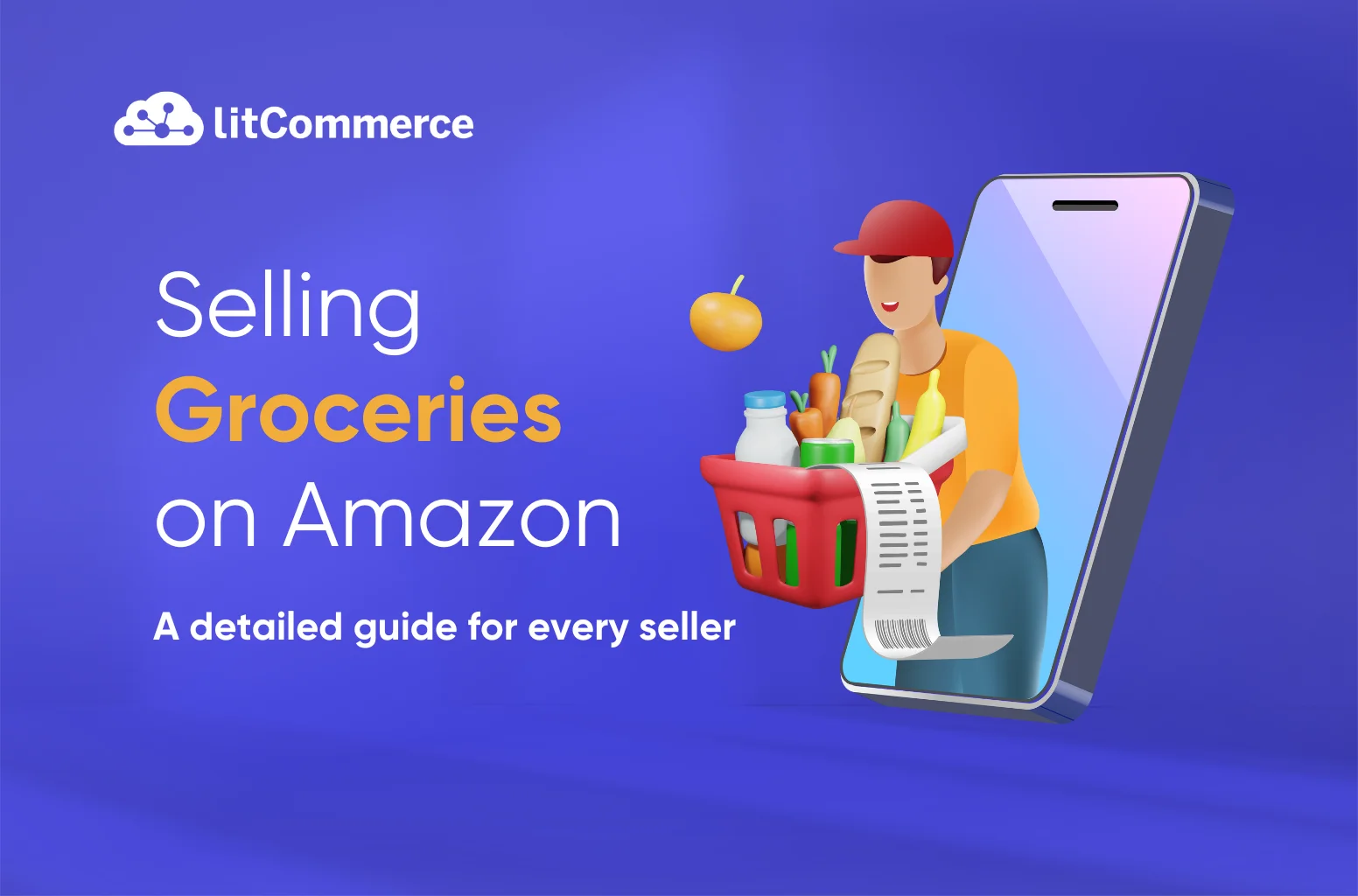Are you considering selling groceries on Amazon? With its continuous growth and Amazon’s strategic focus on expanding its share, now is an opportune time. Compared to categories like electronics or clothing, the grocery sector may be overlooked, but this also means it’s less competitive.
Plus, according to Jungle Scout, recent trends indicate a surge in online grocery shopping on Amazon. So, it is the best time for sellers to leverage the untapped potential of this market.
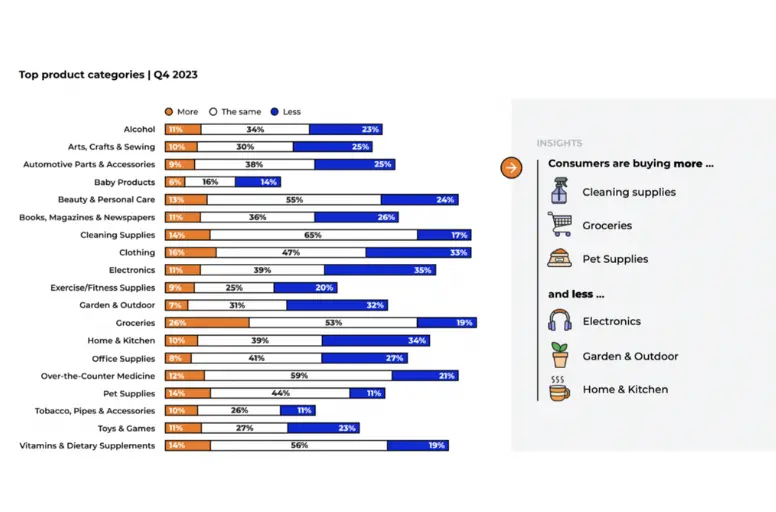
Unsure where to begin or make money selling groceries on Amazon? Don’t worry! Our comprehensive guide offers insights to navigate selling groceries on Amazon effectively. This guide covers:
- How to get approved to sell groceries on Amazon?
- What are the requirements for selling groceries on Amazon?
- Is selling groceries on Amazon profitable?
- How to sell grocery items on Amazon?
- Best-selling grocery items on Amazon
- Best tips for writing grocery product descriptions
Let’s check it out to learn how to make money by selling groceries on Amazon!
How to get Approved to Sell Groceries on Amazon?
New and senior Amazon sellers may encounter restrictions when entering the Grocery & Gourmet Food category. To sell groceries, you must obtain category approval from Amazon. Below are detailed guides that help you quickly get approved to make money selling groceries on Amazon.
Step 1. Apply for grocery category approval
To sell groceries, you need to have a Professional Seller Account. This is because selling groceries is only available to professional sellers.
After you have a Professional Seller Account, follow these steps to apply to sell groceries on Amazon:
- Start by copying the ASIN of a product within the Grocery category. You should choose products that are precisely the same as those you will sell on Amazon.
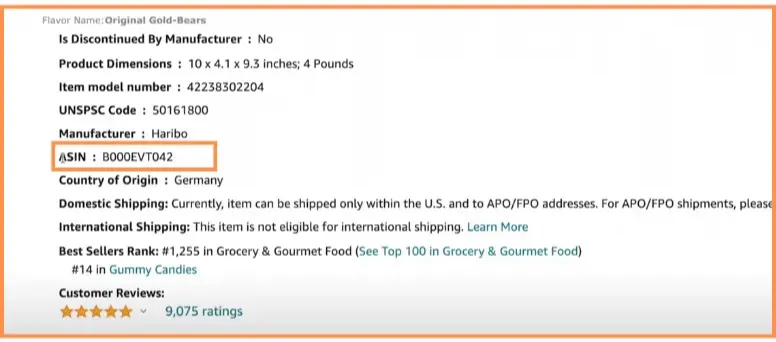
- Access the “Add product” section to your Seller Central account. Then, paste the ASIN to find the product in Amazon’s catalog.

- Choose “new” under “select condition” and click “Apply to sell.”
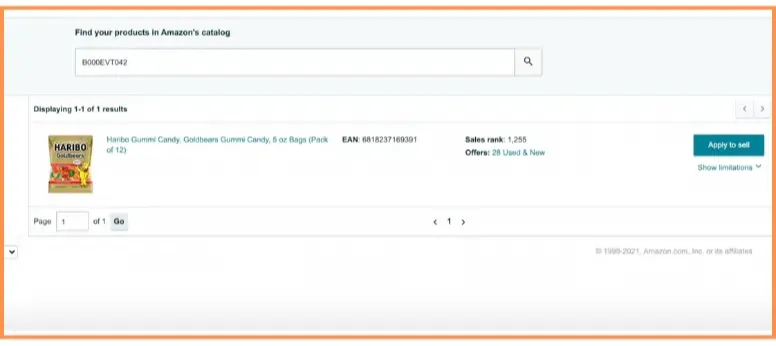
- Hit “Request approval” to proceed with your application.

Step 2: Fill out your document
Prepare required document
For a successful application for selling groceries on Amazon, You would prepare for the document to submit on Amazon. Here is what you should prepare:
- Find a trusted distributor that Amazon has accepted. You can choose to get products from an approved distributor or the brand itself.
- Find products that Amazon accepts for sale. Search for the product name on Amazon to see whether anyone else has sold it. If it has been sold, Amazon will accept that product.
- Order 10 units of the product first since you need to submit the invoice and product photos when applying.
- Take a photo of the invoice, all 10 products from different angles, and their packages. The invoice should include the buying date, shipping address, product name, ordered units, and receiver’s name, matching those on the Amazon Seller Center.
- Prepare other documents related to your business, such as Business licenses, tax registration certificates, FDA registration certificates, or Liability insurance certificates.
Note: If you’re seeking a wholesale or distributor for groceries recognized by Amazon, we suggest Wholesale Frontier Co-Op. They are a reputable wholesale distributor with a wide range of products, and importantly, Amazon accepts their invoices.
Submit the documents
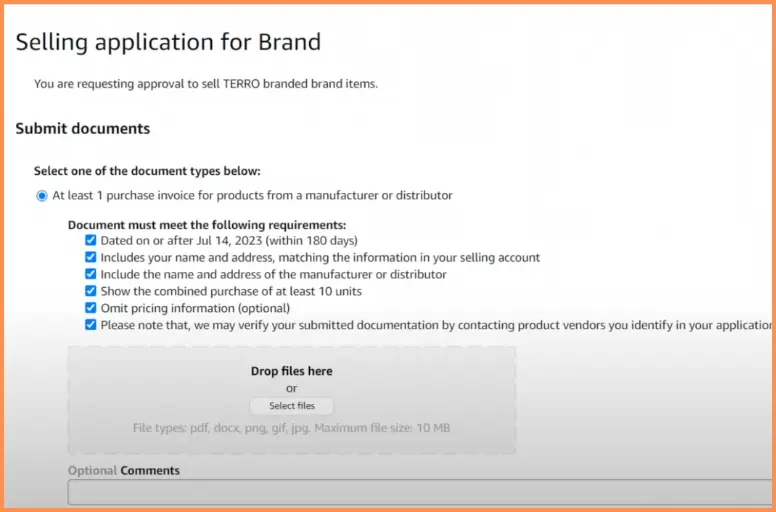
After following the steps above, say you are stopped by a window – Selling Application for Brand.
- From there, click At least on the purchase invoice for a product from a manufacturer or a distributor.
- Go ahead and tick all the checkboxes that indicate the following compulsory requirements for selling groceries on Amazon:
- Recent date: The documentation should include a date within 180 days of when you submit your application.
- Correct name and address: The documents must show your name and address accurately, aligning with the details provided in your selling account.
- Manufacturer/distributor details: The documentation should clearly state the name and address of the manufacturer or distributor linked to the product you plan to sell.
- Minimum purchase quantity: The documents should confirm the purchase of a minimum of 10 product units collectively.
- Submit the document you have prepared, such as:
- Invoices from authorized suppliers
- Product’s photos
- Relevant licenses (If your products are labeled as organic or if you mention “organic” in your listing, Amazon verifies compliance with USDA regulations and demands evidence of your product’s compliance.)
- Write an optional comment: Though this section is optional, many Amazon sellers advise you to fill it out with a brief description of the information in the application. For example, you can type: I ordered (product) from an authorized supplier (supplier name), and I have attached all the information you need above.
- Add your contact email and phone numbers.
Step 3. Submit your application
Ensuring all information is accurate and complete, you can click to submit.
Often, you will hear back within 1 day to up to 3 weeks.
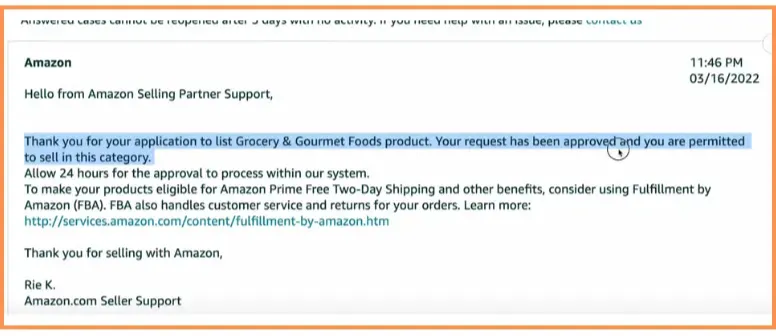
If they denied your application but did not show the reasons, try to resubmit. That may be due to the bot used for auto-checking. If they show you what you forgot to submit, add what Amazon requires and resubmit.
Once you get approval for the first time, you will receive auto-approval the next time you submit if the products you sell are already accepted on Amazon.
Let’s tell the truth: Showcasing your groceries on Amazon is great for reaching new customers. However, listing each item with detailed descriptions can feel like an endless task. What’s special? LitCommerce – a powerful multichannel selling tool can be your inseparable companion. Why? We have a smart bulk listing tool that lets you upload your entire grocery inventory at once, along with other advanced listing features. This will eliminate all the manual work, saving you some valuable time and effort.
What are the Requirements for Selling Groceries on Amazon?
Selling groceries and food items involves a significantly different procedure compared to other product categories due to the nature of dealing with edible goods. So, you need to meet grocery-specific Amazon requirements.
Seller requirements for selling groceries on Amazon
Amazon requires specific performance metrics to sell groceries. These metrics comprise:
- Order defect rate: Less than 1%
- Pre-fulfillment cancel rate: Less than 2.5%
- Late shipment rate: Less than 4%
Failure to meet these standards may result in suspension from selling in the grocery category.
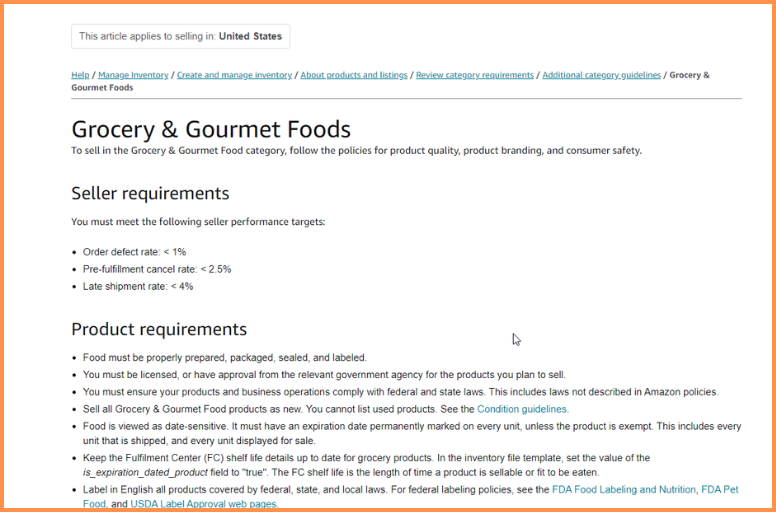
Product requirements for selling groceries on Amazon
To get approved to make money selling groceries on Amazon, you need to fulfill the following requirements:
Amazon’s grocery product requirements
- Food items must be adequately prepared, packaged, sealed, and labeled.
- You must possess licenses or obtain permission from the appropriate state agency for the products you plan to sell.
- Compliance with federal and state laws, including those not explicitly outlined in Amazon policies, is necessary.
- Only new Grocery & Gourmet Food products can be listed; used items are limited.
- Every food product, unless exempt, must bear a marked expiration date on each unit, whether shipped or displayed for sale.
- Set the “is_expiration_dated_product” field to “true” in the inventory file template to maintain accurate Fulfillment Center (FC) shelf life details for grocery items.
- All products must be labeled in English, following federal guidelines provided by the FDA and USDA.
- Food must be enclosed and sealed in appropriate packaging to prevent contamination, spoilage, melting, or damage during shipping.
- Products should be shipped with sufficient remaining shelf life, and the expiration date must not be altered or removed.
- When selling multipack products, the expiration date on the packaging must be the same as the earliest expiration date of the items inside.
- Grocery & Gourmet Food products should be listed using the manufacturer’s UPC unless specified otherwise. Additional guidance is available on listing products without UPCs.
Can’t meet Amazon’s grocery requirements? Consider selling used books instead. Check out our comprehensive guide at How to Sell Used Books on Amazon: A Step-by-step Guide [Latest Updated]
Expiration dates for Amazon groceries
Each food item sold on Amazon is deemed date-sensitive, requiring an expiration date to be permanently marked on every unit unless exempt. Adherence to Amazon’s Expiration Date policy and shelf-life requirements is also needed to list these products for selling groceries on Amazon.
Shelf-life requirements for expiration-dated products
When your products are sent to an Amazon fulfillment center, each unit must have a remaining shelf life of 90 days plus an additional 90 days, which permits ample time for full consumption. For instance, a bottle of supplements containing 90 daily servings should retain a remaining shelf life of 90 days plus an extra 90 days, resulting in a total of 180 days.
Below are additional examples of shelf-life guidelines provided by Amazon for selling groceries on Amazon:
- Chips and other snacks: 90–180 days
- Dried fruit: 180–270 days
- Cereal and granola bars: 180–365 days
- Candy: 540 days
If your products are sold before they reach the end of their shelf life, Amazon will remove them from your inventory and designate them as “unsellable.” It is essential to consistently review and thoroughly understand all of Amazon’s stipulations and conditions.
Meltable FBA inventory
The term “meltable” refers to heat-sensitive items, including chocolate, gummies, and certain jelly—and wax-based products. While you can sell meltable items such as chocolate on Amazon, you should ensure that your inventory complies with FBA’s requirements.
- Acceptance Period: FBA only accepts meltable products between October 16th and April 14th. Items falling within this timeframe are eligible for fulfillment.
- Disposal Policy: Meltable inventory received or stored at Amazon’s fulfillment centers between April 15th and October 15th is deemed unfulfillable and subject to disposal for a fee.
Note: If you believe your product should be exempt from the meltable category, you must provide a letter from the manufacturer confirming that the item can be stored at a max. temperature of 100 degrees Fahrenheit for extended periods. This letter should be submitted to Seller Support for review and consideration.
Chilled and frozen foods
Amazon permits selling chilled and frozen foods. However, sellers must be Fulfilled by Merchant (FBM) and fulfill certain criteria. Also, sellers must provide Amazon with a Food Permit from the FDA and other necessary compliance documents.
Is Selling Grocery on Amazon Profitable?
Online grocery shopping has existed for some time, yet it has recently surged in popularity among global consumers. However, in practice, groceries typically yield a lower return on investment (ROI) for online sellers due to the narrow profit margins associated with individual food items sold on Amazon. However, this fast-moving category also enables sellers to get a high turnover rate. Here are more reasons you should sell groceries on Amazon:
- Product demand: Grocery items are essential and maintain steady demand, rendering them a reliable market to enter. This demand is recurrent as people require groceries daily. From 2018 to 2023, the number of global consumers utilizing online grocery delivery services surged from 547 million to over 1.4 billion (Statistic). Meanwhile, Amazon’s e-grocery sales also reached around $36.4 billion in 2023, with projections suggesting a further rise to $40.5 billion by 2024. All factors considered underscore the substantial growth and sustained appeal of this sector.
- Wide customer reach: Selling groceries on Amazon offers access to a significant portion of the U.S. online grocery market, accounting for 22.0% of the share. With Amazon’s reputation for its vast and diverse customer base, entering the platform means tapping into a broad audience. This presents an opportunity to boost sales and gain exposure to new customers.
- High turnover rate: The consistent need for essential grocery items guarantees a steady stream of sales, which contributes to sustaining a robust revenue flow. This dynamic environment increases inventory turnover, minimizing the risk of stagnant stock and capital tied up in slower-selling products.
How to Sell Grocery Items on Amazon?
After gaining approval in the grocery category, it’s time to explore potential grocery items for sale. Three effective business strategies for the grocery category include retail arbitrage, wholesale, and private label branding.
#1. Amazon Arbitrage
Arbitrage is purchasing products from retail stores or websites at discounted prices to resell on Amazon.
With retail or online arbitrage, you can visit various retail outlets such as local grocery stores, Walmart, Target, and their website to search for profitable products. Here are the pros and cons of Amazon arbitrage:
Pros
- Sellers can discover excellent deals on niche, highly profitable products.
- Arbitrage requires a low upfront cost to enter.
Cons
- It can be a time-consuming sourcing process
- There is an overwhelming array of options available
#2. Wholesale
Wholesalers mean making bulk purchases directly from brands rather than buying individual items from retail stores, as arbitrage does. By adopting wholesale, sellers must create wholesale accounts with authorized distributors or brands. Then, they can resell name-brand grocery products on Amazon. This approach offers an opportunity to build a sustainable Amazon business with readily replenishable products.
Here are the pros and cons of selling groceries on Amazon as a wholesaler:
Pros
- Wholesale suppliers offer larger lots of potentially profitable products at lower prices
- Sourcing from wholesale companies is straightforward and convenient
Cons
- The cost of entry into wholesale sourcing may be higher than arbitrage
- Amazon also sources products from wholesale suppliers, leading to price decreases and increased difficulty in winning the Buy Box
#3. Private Label
The private label method can be effectively utilized in any category, including grocery. However, you will need to prepare more documents to prove your compliance with all local and federal regulations concerning food products. Below are the pros and cons of selling grocery items on Amazon as a private seller:
Pros
- Private labeling allows you to build and control your brand and producers.
- It could be profitable since you obtain the best price directly from the manufacturers.
Cons
- Creating and launching a private-label product typically requires a significant initial investment
- Developing a successful private label product can be a time-consuming
- Private-label products must comply with all relevant regulations and standards
Best Selling Grocery Items on Amazon
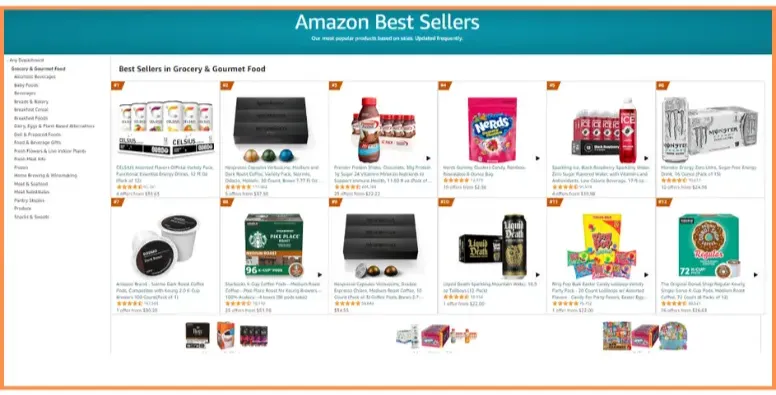
Are you sourcing for profitable and high-demand grocery products to sell on Amazon? We’ve got your back. Below are the 10 best-selling products in the grocery category in March 2024. You choose to sell them to use them for product research:
- CELSIUS Assorted Flavors Energy Drinks
- Nespresso Capsules VertuoLine Pods
- Nerds Gummy Clusters Candy
- Premier Protein Shake
- Sparkling ce, Black Raspberry Sparkling Water
- Starbucks K-Cup Coffee Pods
- Monster Energy Zero Ultra
- Amazon Brand – Solimo Dark Roast Coffee Pods
- Ring Pop Bulk Easter Candy
- The Original Donut Shop Regular Keurig Single-Serve K-Cup Pods
Coffee pods, energy drinks, and candy are the best-selling grocery items. The list can be changed according to specific occasions and seasons, so it’s essential to stay updated to determine what sells best.
Looking to identify your unique selling points? Dive into our guide on competitor analysis Amazon Competitor Analysis: An In-Depth Guide to Decode Your Rivals
Best Tips for Writing Grocery Product Descriptions
When listing your groceries items on Amazon, it’s crucial to fulfill the following requirements:
- Adherence to Amazon’s listing standards: Make sure your product listings meet both Amazon’s general listing standards and the specific criteria set for the Grocery & Gourmet Foods category.
- Dietary and allergen claims: If your product contains dietary or allergen-related assertions (such as Organic, Kosher, Gluten-Free, or Dairy-Free), ensure these claims are clearly indicated on the product label and have received the necessary regulatory approvals.
- All ingredients listed: Your product’s ingredients should be prominently listed throughout your listing. We recommend including a photo of the product’s nutrition facts label, which allows customers to view its contents easily.
- Accuracy in Price Per Unit (PPU): Provide precise PPU information for all new product listings to help customers understand your product’s unit price.
- Focus on a single product: Present only the particular item you’re selling without including any additional items or accessory products. For example, avoid displaying tea or spices alongside a teapot.
Selling groceries on Amazon can be a profitable venture, but it requires careful consideration of factors such as product sourcing, packaging, and shipping. If you’re looking for a less tangible product to sell on Amazon, consider digital goods. Our comprehensive guide on selling digital products provides valuable insights and strategies to help you capitalize on this growing market.
Selling Groceries on Amazon: FAQs
Amazon permits sellers to sell food items such as groceries, gourmet foods, snacks, beverages, and similar products. Nonetheless, sellers must fulfill specific requirements, including acquiring essential certifications and adhering to food safety regulations. The answer is no. Amazon requires considerable data for food products, often demanding independent laboratory testing outcomes. Furthermore, barcodes are essential for selling on Amazon, leading to an additional investment. Optimizing a detail page for food products shares similarities with optimizing pages for products and other categories. However, there are additional considerations, particularly regarding the description. It should include all necessary information, such as: What are the best Grocery items to sell on Amazon? Coffee, snacks, and cooking ingredients are commonly best-selling categories for non-perishable pantry essentials. At the same time, healthy products like organic and gluten-free products are experiencing increasing demand.
Start Selling Groceries on Amazon Now
Selling groceries on Amazon not only assists customers in finding their desired products but also presents a profitable opportunity for sellers. By successfully becoming ungated in the grocery category and sourcing the best selling grocery items on Amazon, you can flourish in the grocery business on Amazon.
If you need more guides like this to learn how to get approved to sell restricted products on Amazon, visit our eCommerce blog. You can also contact us if you need immediate assistance; the LitCommerce team works 24/7 to support you.

